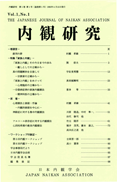Volume 23, Issue 1
Displaying 1-7 of 7 articles from this issue
- |<
- <
- 1
- >
- >|
OPENING REMARKS
-
2017Volume 23Issue 1 Pages 1
Published: September 01, 2017
Released on J-STAGE: December 26, 2020
Download PDF (818K)
SPECIAL CONTRIBUTION
-
2017Volume 23Issue 1 Pages 3-18
Published: September 01, 2017
Released on J-STAGE: December 26, 2020
Download PDF (1137K)
POINT OF CONTENTION
-
2017Volume 23Issue 1 Pages 19-25
Published: September 01, 2017
Released on J-STAGE: December 26, 2020
Download PDF (978K)
ORIGINAL ARTICLES
-
2017Volume 23Issue 1 Pages 27-38
Published: September 01, 2017
Released on J-STAGE: December 26, 2020
Download PDF (1327K) -
2017Volume 23Issue 1 Pages 39-49
Published: September 01, 2017
Released on J-STAGE: December 26, 2020
Download PDF (1274K)
SHORT REPORT
-
2017Volume 23Issue 1 Pages 71-77
Published: September 01, 2017
Released on J-STAGE: December 26, 2020
Download PDF (1290K)
RESEARCH DATA
-
2017Volume 23Issue 1 Pages 79-86
Published: September 01, 2017
Released on J-STAGE: December 26, 2020
Download PDF (1089K)
- |<
- <
- 1
- >
- >|
